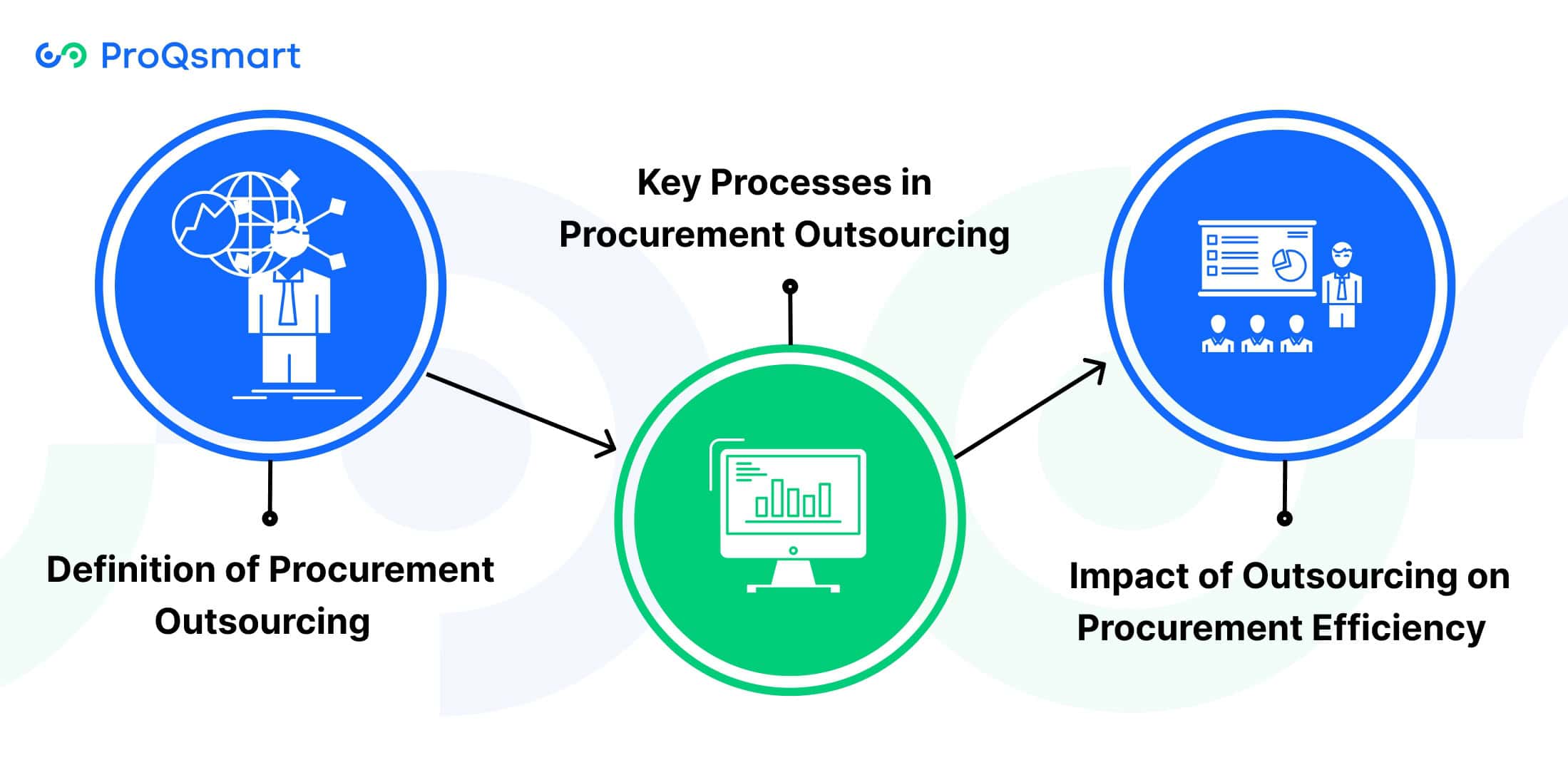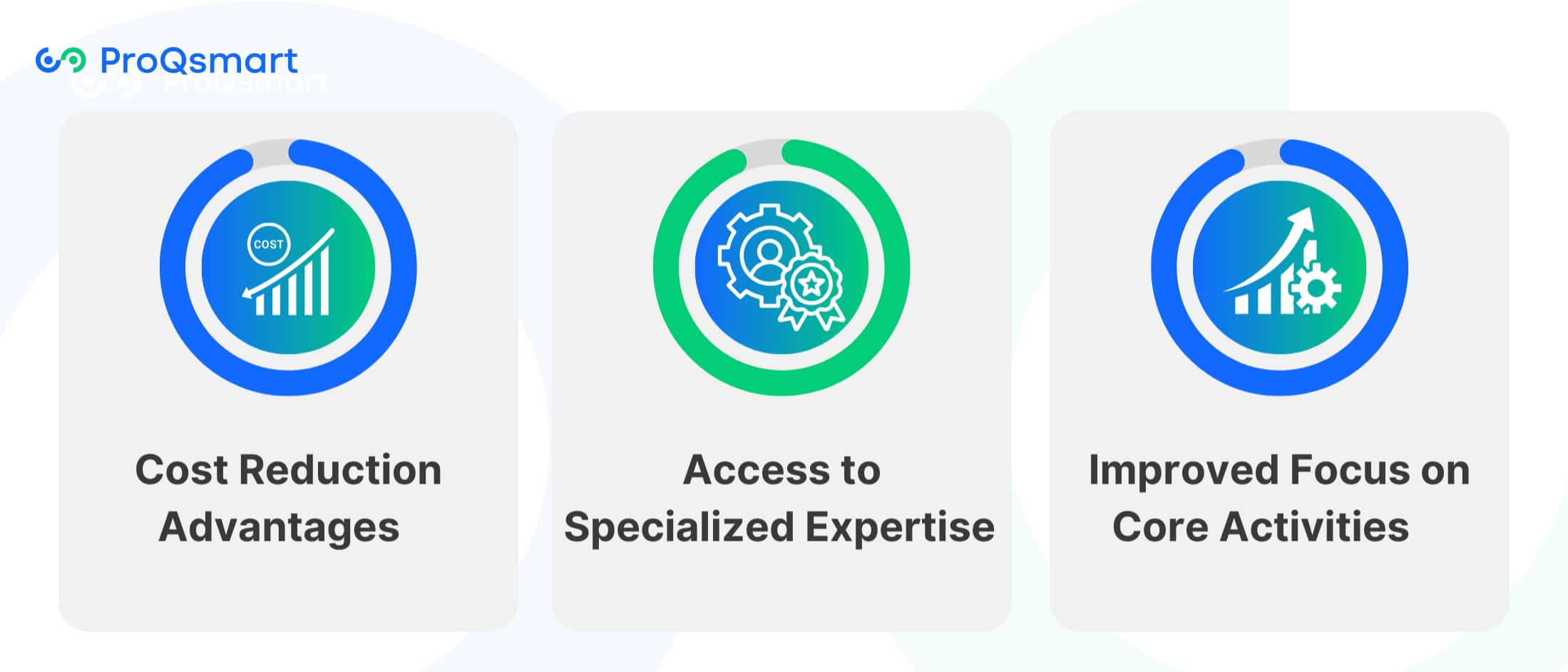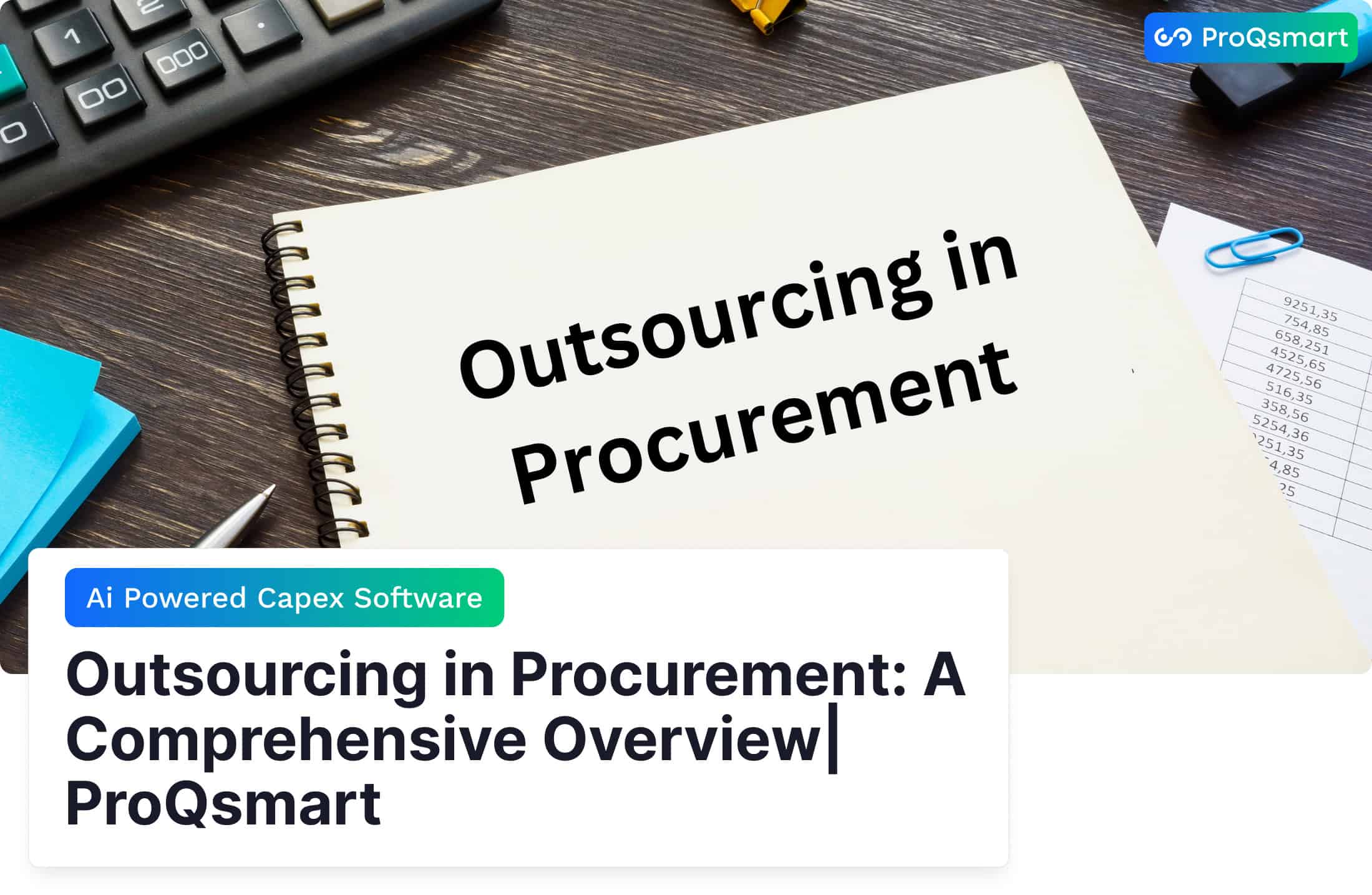Outsourcing involves the delegation of business activities or operations to external third-party vendors. This method increases productivity while saving money. This strategy allows businesses to focus on their key functions.
At the same time, they can outsource niche functions to specialists, resulting in higher productivity and improved business operations. This allows them to leverage external expertise and cutting-edge technologies without needing to invest heavily in-house.
In procurement, outsourcing procurement functions can better manage supply chains by tapping into global markets, reducing risk, and realizing cost savings. By outsourcing to trusted vendors, organizations have the ability to stay on top of strict regulatory compliance and high-quality standards.
This intentional strategy encourages creativity and nurtures sustainable business development.
What Is Outsourcing
Outsourcing is a common and strategic business practice in which companies choose to have a third-party provider handle part of their operations. This strategy is traditionally taken to increase operational efficiency, lower expenses, and direct resources towards the company’s core goals.
By leveraging third-party expertise, businesses can access specialized skills, tools, and innovations that are not readily available in-house. It is hardly surprising that outsourcing has become a cornerstone of contemporary business strategies. It offers an extensive array of benefits designed to attract a wide range of industries.
Definition of Outsourcing
Outsourcing is the practice of relocating certain business operations or processes to third-party individuals or companies. This may include everything from basic functions, such as payroll management, to more advanced offerings, including software development.
Unlike in-house operations, which are managed internally, outsourcing allows businesses to engage external providers who bring additional expertise and infrastructure to the table. This approach is both smart and powerful. It increases resource efficiency by focusing internal resources on the highest-value activities while outsourcing non-core or resource-heavy functions.
Importance of Outsourcing in Business
Outsourcing allows businesses to focus their energies on their core competencies, like innovating new products or expanding into new markets. By outsourcing secondary operations, businesses not only increase efficiency but save costs.
Outsourcing encourages dynamicity. With outsourcing, companies can quickly increase or decrease operations based on changing market needs without stretching in-house capabilities too thin. This flexibility is incredibly useful for industries undergoing a period of fast technological or economic change.
With the right partner in place, outsourcing gives companies access to valuable intellectual property and innovative concepts tied to specialized external teams. This control helps businesses stay competitive in fast paced, dynamic markets.
Role of Outsourcing in Procurement

Procurement outsourcing has become a popular tactic for companies looking to improve their procurement function. Organizations can improve their efficiency by outsourcing certain procurement functions to outside specialists. This approach lets them hone in on their core competencies and tap specialized expertise.
Through the automation of workflows and increase of overall efficiency, outsourcing has proven itself to be a cornerstone for procurement process optimization.
Definition of Procurement Outsourcing
Procurement outsourcing simply means passing procurement operations over to the experts. This covers functions such as supplier management and sourcing strategy. This strategy has a proven track record of making procurement perform better, especially for the firms that have the most substantial or demanding procurement requirements to manage.
For example, one European utility decision to outsource its purchasing function resulted in both measurable cost savings and faster delivery of services. Outsourcing comes into play especially when firms encounter problems that need niche expertise or sophisticated methodologies that don’t already exist internally.
Key Processes in Procurement Outsourcing
Key processes frequently outsourced include contract negotiation, supplier performance management, and in some cases, even category-specific procurement. Using technology, like e-procurement platforms, streamlines the process through automation, making it faster, easier and more efficient.
Documentation is key in this aspect, creating a paper trail and allowing for transparency and alignment between your company and your outsourcing partner. This shift demonstrates the powerful role that outsourcing can play to improve focus on strategic categories.
Impact of Outsourcing on Procurement Efficiency
Outsourcing increases efficiency by cutting operational costs and freeing up valuable time. One of the world’s largest food companies outsourced the management of its packaging materials. This decision saved more than 80 hours of procurement time and yielded a remarkable 17X ROI.
By leveraging industry expertise, the specialized vendor arms businesses with best practices that help them realize savings of up to 50% by correcting internal inefficiencies.
Benefits of Outsourcing in Procurement

Whether it’s procurement, supply chain management, or another business function, outsourcing services provide organizations an opportunity to do more with less and leverage specialized expertise. By engaging in business process outsourcing for procurement with trusted third-party experts, businesses of all sizes can improve their efficiency, focus, and agility in meeting changing market demands. Below, we dive into the four main benefits in depth.
Cost Reduction Advantages
Outsourcing procurement is a tested and trusted strategy to realize these kind of cost savings. Businesses can reduce their operating costs to save up to 19%. By addressing the first few categories of spend, they’re able to realize savings in almost a third of spend.
Removing these overhead expenses for an in-house procurement team allows companies to save millions. They can then take that freed-up cash and invest in other priorities. Specialized service providers also bring financial benefits in the form of economies of scale.
For example, outsourcing to indirect procurement experts like ProQsmart allows companies to optimize supplier performance within specific categories, achieving annual returns three to eight times higher than the fees incurred. These providers are often better, armed with procurement-specific tools and market intelligence to negotiate for better terms, find cost-saving opportunities, and maintain compliance.
Access to Specialized Expertise
Outsourcing provides companies access to procurement experts who offer specialized knowledge and experience. This depth of expertise allows organizations to achieve a level of competitive advantage by staying ahead of the curve with best practices, market intelligence, and cutting-edge technologies.
Partnering with ProQsmart gives you access to innovative, AI-driven tools. These tools empower you to easily create and manage e-tenders, automate workflows, and monitor supplier performance across all suppliers.
These capabilities significantly expedite all sourcing activities and allow procurement strategies to be more aligned with operational needs and goals.
Improved Focus on Core Activities
Outsourcing procurement functions enables companies to focus on their core goals. This allows internal teams to refocus their time and energy on more strategic initiatives, like innovation and customer-facing activities, increasing productivity across the board.
By leveraging the expertise of third-party providers, businesses can enable better customer service levels and reap the rewards of long-term, sustainable growth.
Challenges of Outsourcing in Procurement
Outsourcing procurement allows businesses to concentrate on their core business operations by leveraging specialized outsourcing services for non-core functions like procurement of office supplies or IT equipment. While outsourcing can significantly enhance efficiency, it does come with challenges that may impact quality and overall organizational functioning. Addressing these challenges is crucial to ensure that outsourcing empowers organizations to achieve greater outcomes, rather than leading to unintended negative consequences often associated with outsourcing relationships.
Communication and Coordination Issues
The first and most important challenge present in outsourcing procurement is communication. This sort of miscommunication or misunderstanding of expectations between a company and its procurement outsourcing partner can result in costly delays, errors, and inefficiencies. If a third-party vendor fails to understand the client’s IT equipment specifications, they can end up ordering the wrong items.
This sometimes results in equipment that does not adequately address operational needs. To counteract this, open channels of communication are key. Frequent meetings, thorough documentation, and ongoing reporting can fill those voids.
In addition, employing collaboration tools and clearly establishing roles and responsibilities from the start allows for clear communication from day one. For example, naming a mutually agreed upon point of contact on both sides of the contract helps to prevent the essential information from getting clogged up.
Risk of Quality Control Problems
Quality is a common concern when a business engages in outsourcing services, as it turns control over to an outside party. Without that direct oversight, there’s a greater risk of receiving subpar goods or services, which can bring operations to a grinding halt. For instance, inadequate procurement of maintenance services might lead to increased asset downtime or even a safety issue.
Mitigating this calls for a strong vendor management process. Evaluation of outsourcing providers against their past performance, certifications, and compliance standards is key. Regular performance reviews and audits keep vendors in check and ensure they align with the standards set during onboarding.
Service Level Agreements (SLAs) can provide a formalized framework to resolve quality issues, enhancing the overall outsourcing relationship.
Dependency on External Vendors
Over-reliance on an outsourced vendor can create a crutch. This is a huge issue if the vendor fails to perform or the vendor chooses to terminate the contract. For instance, a contractor for important janitorial services not performing can severely impact day to day functions.
Corporate leaders need to pursue strategies that reduce dependence. Ways to mitigate these risks include diversifying outsourcing partners and keeping in-house expertise for critical functions. Contingency plans—like identifying backup suppliers or using short-term contracts—can help protect operations from this type of disruption.
Best Practices for Overcoming Challenges
Outsourcing in procurement provides significant potential for reducing expenditures and increasing productivity. It also opens the door to new challenges that require thoughtful strategic navigation. Overcoming these challenges comes down to implementing best practices to keep things running smoothly and maintain positive, productive relationships with outsourcing partners.
Here are some key strategies to overcome these obstacles:
1. Establish Clear Goals and Expectations
It’s important for the goals of the outsourcing to be very specific. Clear goals define the scope of work, expected outcomes, and timelines, enabling all parties to remain aligned. If you outsource supplier performance monitoring, include specific metrics such as on-time delivery performance and cost savings.
This method ensures you’ll be looking at measurable success. Setting clear expectations avoids confusion and lack of clarity, making for a more collegial working environment and greater accountability during the development process.
2. Choose Reliable Outsourcing Partners
Identifying dependable providers requires evaluating their expertise, track record, and transparency. Selecting partners with pre-vetted teams, such as those offering accounting talent can optimize recruitment time and ensure quality.
Conducting thorough due diligence, including site visits or client references, helps assess their capabilities and commitment to confidentiality.
3. Implement Robust Communication Strategies
Healthy communication structures support outsourced campaigns and improve the working relationship. Using software such as ProQsmart facilitates easy communication, even if you’re half a world away.
Making sure to schedule overlapping hours, especially for complicated discussions, helps with real-time collaboration. Consistent communication and iterative feedback processes help build ongoing trust and alignment, especially in sensitive areas such as data security.
4. Monitor and Evaluate Vendor Performance
By using KPIs to track vendor performance, you can hold vendors accountable. Metrics like contract compliance or cost per mile give quantifiable, objective yardsticks for measuring success or failure as the project progresses.
Smart platforms, such as ProQsmart, automate supplier performance monitoring to create visibility and provide actionable insights to help you address issues as they arise and maintain compliance.
5. Use Technology for Better Collaboration
Instead, technology helps bridge the gaps and makes outsourcing a non-issue. Tools like ProQsmart streamline workflows, automate subcontractor management, and ensure budget alignment.
ProQsmart’s real-time tracking and AI-driven insights cut through the noise and make complicated processes seem easy, enabling seamless collaboration. Leveraging such platforms breeds efficiency while eliminating a lot of cultural and operational friction.
Importance of E-Sourcing Software for Outsourcing
Soaring costs, quality discrepancies, and security issues have made e-sourcing software a non-negotiable part of the new procurement landscape for any business savvy enough to outsource. Almost nine out of ten companies depend on procurement strategies.
E-sourcing software provides them with the visibility and connectivity needed to speed up processes, improve supplier collaboration, and reduce costs efficiently. By embracing these technologies, organizations can raise the strategic profile of procurement and do so as they pursue broader business objectives.
How E-Sourcing Improves Procurement Outcomes
- E-sourcing software is the secret sauce that puts procurement success on autopilot with automated, simplified, streamlined processes. Companies can streamline RFx processes such as RFI and RFP.
- This allows them to collect deep information about potential suppliers and solicit competitive bids. This helps make sure that they’re taking a standardized, fair approach to sourcing, and it encourages transparency.
- Organizations can run all types of auctions, including reverse, Dutch, or Japanese auctions. This skill allows them to arbitrate the best suppliers to the best terms.
- Real-world examples have proven that e-sourcing can be transformational. Companies that have implemented these solutions are experiencing less rogue spending, more efficient workflows, and better supplier performance.
- ProQsmart’s AI-powered procurement platform provides advanced features such as e-tendering, collaboration in real-time, and procurement based on budgets. These tools result in millions of dollars in cost savings and increased compliance.
- Businesses that utilize ProQsmart are further advantaged by supplier performance monitoring and capital expenditure sourcing, for accurate and efficient outsourcing management.
- The strategic advantages are just as persuasive. With e-sourcing software, procurement gains the real-time visibility into supplier relationships and sourcing activities needed to make the right decisions—all informed and data-driven.
- Trust-based relationships with suppliers, cultivated through these platforms, result in more effective partnerships and long-term success in outsourcing endeavors.
Conclusion
Procurement outsourcing delivers tremendous value when approached with caution and strategic foresight. By reducing expenses, increasing productivity, and allowing teams to focus on their core competencies, it can transform the way businesses operate. However, being aware of potential pitfalls and adopting prudent practices is essential to leverage these opportunities effectively. Solutions such as e-sourcing software can enhance transparency during the procurement process, accelerate decision-making, and strengthen supplier relationships.
These steps may seem small, but every action counts. From selecting the right partners to leveraging necessary tools, success in outsourcing follows well-planned strategies. It’s not just about staying on the cutting edge; it’s about anticipating market needs and ensuring your business is enterprise-ready.
Put your procurement strategy back in your hands. Use ProQsmart as a tool to achieve measurable results. Stay hungry, stay foolish, and make decisions that best position your business for future success. Book a demo today to discover how ProQsmart can empower your procurement processes and drive your business forward!




